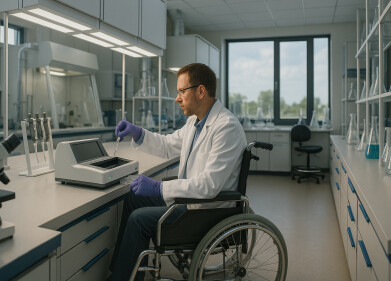News
Irish Researchers Create Wearable Sensors Using Rubber Bands
Aug 29 2014
Researchers at AMBER, the Science Foundation Ireland funded materials science centre, and the School of Physics, Trinity College Dublin, have discovered a method of creating wearable sensors by adding graphene to shop-bought rubber bands; the first time this has ever been achieved worldwide. Researchers at the University of Surrey have also been collaborating on the project.
The team - led by Professor Jonathan Coleman, one of the world’s leading nanoscientists - infused rubber bands with graphene, a nano-material derived from pencil lead which made the rubber bands electrically conductive without degrading the mechanical properties of the rubber. Tests showed that, any electrical current flowing through the graphene-infused rubber bands was very strongly affected if the band was stretched. As a result, if the band is attached to clothing, the tiniest movements such as breath and pulse can be sensed.
The discovery opens up a host of possibilities for the development of wearable sensors from rubber, which could be used to monitor blood pressure, joint movement and respiration. Other applications could extend to the of rubber-graphene sensors could be in the automotive industry (to develop sensitive airbags); in robotics, in medical device development (to monitor bodily motion), as early warning systems for cot death in babies or sleep apnoea in adults. They could also be woven into clothing to monitor athletes’ movement or for patients undergoing physical rehabilitation.
Professor Jonathan Coleman, AMBER, said, “Sensors are becoming extremely important in medicine, wellness and exercise, medical device manufacturing, car manufacturing and robotics, among other areas. Biosensors, which are worn on or implanted into the skin, must be made of durable, flexible and stretchable materials that respond to the motion of the wearer. By implanting graphene into rubber, a flexible natural material, we are able to completely change its properties to make it electrically conductive, to develop a completely new type of sensor. Because rubber is available widely and cheaply, this unique discovery will open up major possibilities in sensor manufacturing worldwide.”
Corresponding author, Dr Alan Dalton from the University of Surrey continued, “Until now, no such sensor has been produced that meets needs and that can be easily made. It sounds like a simple concept, but our graphene-infused rubber bands could really help to revolutionise certain aspects of healthcare.”
The paper, Sensitive, High Strain, High-rate, bodily motion Sensors based on Graphene-Rubber Composites, written by AMBER researchers along with collaborators from the University of Surrey is available at: http://ilmt.co/PL/jAL
Digital Edition
Lab Asia Dec 2025
December 2025
Chromatography Articles- Cutting-edge sample preparation tools help laboratories to stay ahead of the curveMass Spectrometry & Spectroscopy Articles- Unlocking the complexity of metabolomics: Pushi...
View all digital editions
Events
Jan 21 2026 Tokyo, Japan
Jan 28 2026 Tokyo, Japan
Jan 29 2026 New Delhi, India
Feb 07 2026 Boston, MA, USA
Asia Pharma Expo/Asia Lab Expo
Feb 12 2026 Dhaka, Bangladesh



















